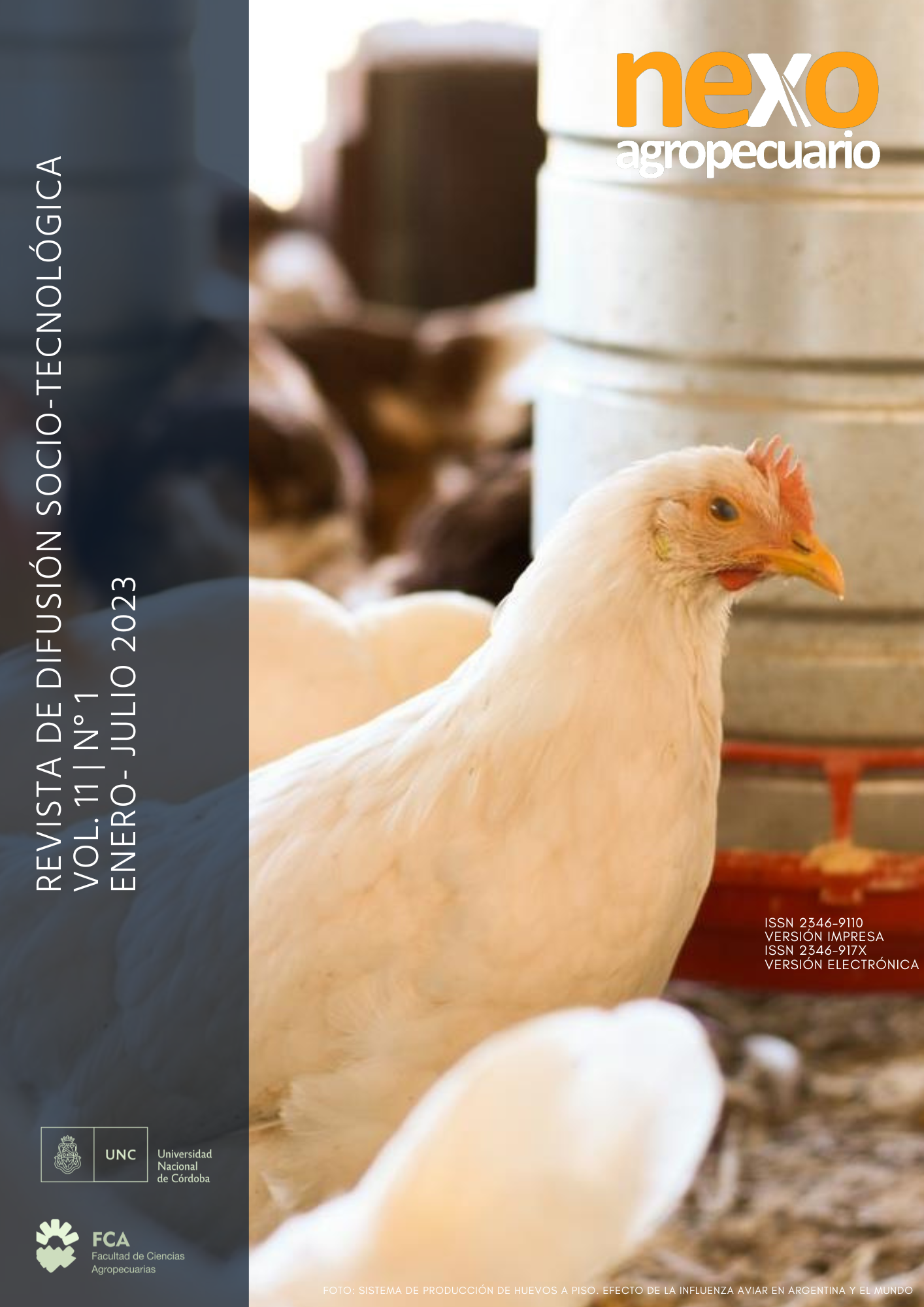AVANCES EN LA EPIDEMIOLOGIA DEL “MARCHITAMIENTO DE LA REMOLACHA” EN REGIONES PRODUCTORAS DE REMOLACHA FORRAJERA DE RIO NEGRO Y BUENOS AIRES.
Palavras-chave:
Fitoplasmas, Vectores, amarillamiento, ForrajesResumo
En Valle Medio e Inferior de Río Negro y en la región sur de la provincia de Buenos Aires se encuentra en expansión el cultivo de remolacha forrajera (Beta vulgaris var. rapacea) debido a que es una alternativa nutricional para la producción de ganado durante los periodos invernales. El éxito del cultivo está condicionado por distintos factores bióticos, siendo la enfermedad causada por un fitoplasma llamada “marchitez de la remolacha”, el más importante. El presente trabajo pretende aportar conocimientos sobre los componentes que integran el patosistema Beta vulgaris /fitoplasmas /insectos vectores. Se realizaron muestreos en la zona de producción para analizar la presencia, sintomatología y evolución de la enfermedad. Al ser un patógeno transmitido por hemípteros y con la finalidad de identificar la fauna de insectos potencialmente vectores asociados al complejo Beta vulgaris se realizaron redadas en el cultivo y malezas aledañas. Los resultados demuestran la presencia de un único fitoplasma (subgrupo 16SrIII-J, FodderBeet). La sintomatología predominante es el amarillamiento, encontrando también marchitamiento y superbrotamiento. Se continua este trabajo con la finalidad de establecer las especies vectoras de la enfermedad y su ciclo de vida.
Referências
Bertaccini A, Duduk B, et al. (2014). Phytoplasmas and Phytoplasma Diseases: A Severe Threat to Agriculture. American Journal of Plant Sciences 5, 1763-1788
Bertaccini, A., Arocha-Rosete, Y., Contaldo, N., Duduk, B., Fiore, N., Montano, H. G., & Zamorano, A. (2022). Revision of the ‘Candidatus Phytoplasma’species description guidelines. International Journal of Systematic and Evolutionary Microbiology, 72(4), 005353.
Bertaccini, A., and Lee, I.-M. (2018). “Phytoplasmas: an update,” in Phytoplasmas: Plant Pathogenic Bacteria - I: Characterization and Epidemiology of Phytoplasma - Associated Diseases, eds G. P. Rao, A. Bertaccini, N. Fiore, and L. W. Liefting (Singapore: Springer), 1–29. doi: 10.1007/978-981-13-0119-3-1
Conci, L.; Saavedra Pons, A. et al. (2014) Advances in knowledge about phytoplasma diseases in Argentina. Chapter 2: The phytoplasmas and phytoplasma vectors. In Phytoplasmas and Phytoplasma Diseases management. Ed. A. Bertaccini. Bologna, Italia. ISBN 978-88-909922-0-9 pg 288
Deitz, L. y Dietrich, C. (1993) Superfamily Membracoidea (Homoptera: Auchenorrhyncha). Introduction and revised classification with new family-group taxa. Systematic Entomology 18: 287-296.
Deng, S.J. and Hiruki, C. (1991) Genetic relatedness between two non-culturable mycoplasma-like organisms revealed by nucleic acid hybridization and polymerase chain reaction. Phytopathology, 81, 1475-1479. http://dx.doi.org/10.1094/Phyto-81-1475
Doyle J, Doyle JL (1990) Isolation of plant DNA from fresh tissue. Focus 12:13–15
Favere, V. M. (2021). Cultivo y uso de la remolacha forrajera para pastoreo directo - Web INTA Digital (INTA) - http://hdl.handle.net/20.500.12123/13232
Fernández, F.; Guzmán, F.; Baffoni, P.; Reinoso, L.; Kiehr, M.; et al. (2020a); Phytoplasmas of subgroup 16SrIII-J associated with Beta vulgaris in Argentina; Sociedade Brasileira de Fitopatologia; Tropical Plant Pathology; 45; 2; 2-2020; 143-147
Fernández, F.; Alessio, F.; Bongiorno, V.; Galdeano, E. y Conci L. (2020b) Minireview Enfermedades causadas por Fitoplasmas. Situación en Argentina - Boletín de la Asociación Argentina de Fitopatólogos ISSN: 2618-1932 Dic. N°7. http://aafitopatologos.com.ar/wp/wp-content/uploads/2020/12/Boletin-N-7-AAF.pdf
Galdeano E, Guzmán F, Fernández F and Conci L. (2013) Genetic diversity of 16SrIII group phytoplasmas in Argentina. Predominance of subgroups 16SrIII-J and B and two new subgroups 16SrIII-W and X. European Journal of Plant Pathology. 137:753-764. DOI: 10.1007/s10658-013-0285-5
Galdeano, E.; Torres, L.; Meneguzzi, N.; Guzmán, F.; Gomez, G.; Docampo, D. and Conci, L. (2004). Molecular Characterization of 16S ribosomal DNA and phylogenetic analysis of two X-disease group phytoplasmas affecting China-tree (Melia azedarach L.) and Garlic (Allium sativum L.) in Argentina. Journal of Phytopathology 152 (3), 174-181.
Galetto L, Bosco D, et al. (2011). The Major Antigenic Membrane Protein of “Candidatus Phytoplasma asteris” Selectively Interacts with ATP Synthase and Actin of Leafhopper Vectors. PLoS ONE, 6:e22571
Gundersen, D.E. and Lee, I.M. (1996) Ultrasensitive detection of Phytoplasmas by nested-PCR assays using two universal primer pairs. Phytopathologia Mediterranea, 35, 114-151.
Lee, I.-M., D. E. Gundersen-Rindal et al. (1998). Revised Classification Scheme of Phytoplasmas based on RFLP Analyses of 16S rRNA and Ribosomal Protein Gene Sequences. Int. J. Syst. Bacteriol. 48, 1153-1169.
Linnavuori, R. 1959. Revision of the Neotropical Deltocephalinae and some related subfamilies (Homoptera). Annals of Zoological Society, Vanamo 20: 1-370.
Marcone, C. (2014). Molecular biology and pathogenicity of phytoplasmas. Ann Appl Biol 165 199–221
Pérez-López, E.; Luna-Rodríguez, M. et al. (2016). The underestimated diversity of phytoplasmas in Latin America. Int J Syst Evol Microbiol. 66(1):492-513
Rashidi, M.; Galetto, L. et al. (2015). Role of the major antigenic membrane protein in phytoplasma transmission by two insect vector specie. BMC Microbiology DOI 10.1186/s12866-015-0522-5
Remes Lenicov, A. 1982. Aportes al conocimiento de los Agalliinae argentinos. (Homoptera-Cicadellidae). Neotrópica 28 (80): 125-138.
Weintraub P. (2007) Insect vectors of phytoplasmas and their control an update. Bulletin of Insectology, (2007), 169-173, 60(2)
Weintraub, P., L. Beanland. (2006). Insect vectors of phytoplasmas. Ann. Rev. of Entl., 51: 91-111
Wei W, Zhao Y. Phytoplasma Taxonomy: Nomenclature, Classification, and Identification. Biology (Basel). 2022 Jul. 26;11(8):1119. doi: 10.3390/biology11081119. PMID: 35892975; PMCID: PMC9394401
Downloads
Publicado
Edição
Seção
Licença
Copyright (c) 2023 Vanina Bongiorno, Luis Conci, Florencia Alessio, Verónica Favere, Patricia Baffoni, Franco Fernandez, María Inés Catalano

Este trabalho está licenciado sob uma licença Creative Commons Attribution-NonCommercial-ShareAlike 4.0 International License.
Atribución – No Comercial – Compartir Igual (by-nc-sa): No se permite un uso comercial de la obra original ni de las posibles obras derivadas, la distribución de las cuales se debe hacer con una licencia igual a la que regula la obra original.


